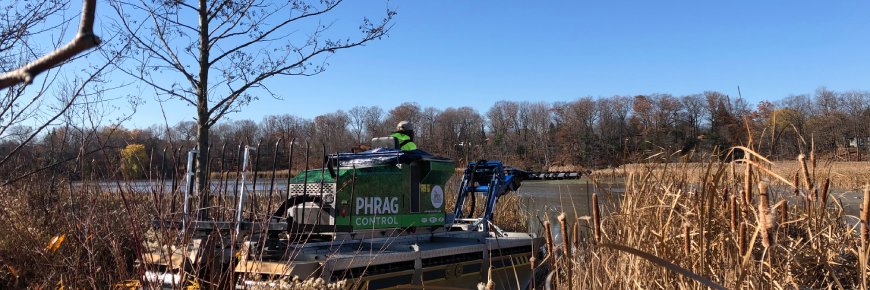
Latest news
Rouge National Urban Park
Follow our projects team as they work to enhance the infrastructure and ecological integrity of the Rouge Beach area of Rouge National Urban Park!
2024
Rouge Beach Day Use Area enhancements
In summer 2024, Parks Canada resurfaced the concrete foundation of the former washroom building to create a new public area with a soft, non-slip rubber surface similar to those found in playgrounds. The area was then outfitted with picnic tables, cozy hammocks, and shade sails, making it a perfect spot to relax and soak up the beach experience.
The addition of non-slip accessible "mobi-mats" from the enhanced area to the shore enables easier beach access for visitors using wheelchairs and strollers. This makes it the first accessible beach in the GTA!
Beach-goers tell us that they love these new amenities and can look forward to enjoying them seasonally!
Three Years of Fishing Line Recycling Success
This August, Rouge Beach marked a significant environmental milestone—the three-year anniversary of the Clear Your Gear fishing line recycling program. Since the installation of these recycling receptacles, they have quietly contributed to a cleaner and safer beach, with impressive results.
Over the past three years, 25 kilometers of fishing line have been collected—enough to stretch across the entire park from north to south! The collected line will be sent to a recycling facility, where it will be transformed into underwater fish habitat structures, made from the recycled fishing line and other post-consumer materials like milk cartons and water bottles.
Check more sustainability initiatives at the park.
Decommissioning of washroom building at Rouge Beach
In 2024, Parks Canada addressed the deteriorating washroom facility at Rouge Beach, which was reaching the end of its life cycle. Its close proximity to the Rouge River and Lake Ontario shoreline posed significant risks of erosion and flooding. As a result, the decision was made to decommission and remove the building in March 2024.
The permanent accessible washroom facility planned for Rouge Beach will be built once shoreline erosion protection measures are in place to ensure its durability and long-term viability.
In the meantime, temporary mobile washrooms will be set up at Rouge Beach during the peak operational season to ensure visitors have access to facilities.
Additionally, as part of the Rouge Beach Improvements Project's first phase, a new two-unit accessible washroom will be constructed near the upper parking area.
2023
Phragmites be gone
In fall 2023, Parks Canada successfully removed 1.3 hectares of invasive phragmites with state-of-the-art amphibious machinery. Planned invasive species removals are integral to restoring Rouge Marsh, protecting native vegetation and increasing the amount of wildlife habitat. Now in its third year, Parks Canada will continue to monitor the effectiveness of removals seasonally to determine future restoration actions.2022
Shoreline Remediation Work Completed at Rouge Beach
The Toronto and Region Conservation Authority (TRCA) has completed shoreline remediation work to restore the traditional outflow of the river into Lake Ontario. Check out the before and after images to see how much beach habitat has been regained!
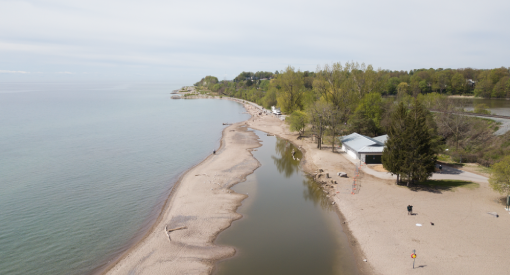
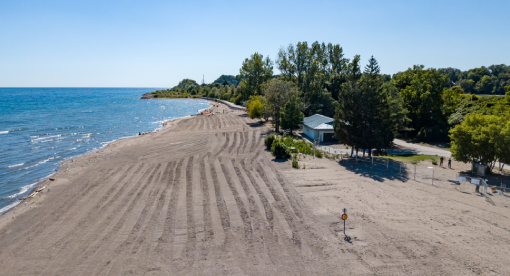
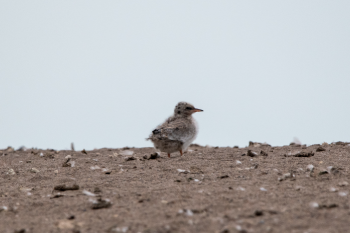
While remediation work was expected to get underway earlier in the summer, nature had other plans. Parks Canada team members discovered common terns nesting on the exposed sandbar and delayed work to protect the success of the nest. We are happy to share the news that the baby terns have fledged and taken flight with their family.
Parks Canada sincerely thanks the public for their patience as we worked to remediate the shoreline erosion and make the beach a safer place for all.
While most visitors were very understanding and supportive of the reasons for moving forward with this work, there were others who voiced concerns about disturbing natural processes by removing the sediment to restore the outflow of the river. The mouth of the Rouge River is a dynamic system that is continually changing. While the exact location of the river mouth varies from year to year, this season, the exposed sandbar diverted the outflow of water in such a way as to create immediate risks to infrastructure, public safety and the stability of trees, specifically:
- the potential release of contaminants into the lake if the washroom building and septic system became breached;
- the destabilization of mature trees along the beach and waterfront trail, four of which had to be removed for public safety after becoming a falling risk;
- the pooling of stagnant water leading to high levels of bacteria, including E. coli;
- unsafe conditions for the public, including unpredictable water currents, steep drops in elevation on the eroded shoreline and unstable terrain.
Climate change impacts to coastal environments are particularly complex, and the Agency is committed to integrating climate change mitigation and adaptation actions on lands and in waters administered by Parks Canada.
To help address some of these issues, Parks Canada is working on a comprehensive Rouge Beach Improvements Project, that aims to mitigate the impacts of climate change and flooding by flood-proofing the access road to the beach area as well as by decommissioning a flood prone parking lot and relocating parking options further up slope and away from the flood zone.
In addition, and over the long term, Parks Canada is working with the TRCA to develop a Rouge Beach stabilization strategy to further protect the beach and shoreline against longshore erosion. Our teams are working with coastal engineers to propose measures to reduce erosion, stabilize and grow the beach through natural long shore deposition. Surveying, archeology and investigation are underway to better understand the lake dynamics in the Rouge Beach area. Long-term shoreline protection measures will be undertaken as a separate project and may include groynes, rip-rap and a variety of other structures and interventions to further protect the shoreline and beach assets and infrastructure such as the Waterfront Trail, rail line and washroom area. Once a detailed design and costing is completed, and project parameters defined, Parks Canada will prioritize the project for completion in the next 10 years.
Marsh Madness!
You have undoubtedly seen this invasive reed near wetlands, along roadside ditches and the Rouge Marsh. Meet Phragmites australis. They may look pretty bending in the wind, but are devastating to marsh and wetland habitats as they kill and choke out native plants and grow in a dense, impenetrable mass pushing out birds, mammals, and other wildlife.
This past year, more than 5 hectares of invasive Phragmites australis were removed from wetlands in the park, south of the 401. While some Phragmites were hand-pulled by a dedicated group of staff and volunteers, a cool machine, affectionately called the “Marsh Muncher” also stepped in to give a little mechanical help to our friends. This machine munches and mows the invasive plant under water to drown the stems and reduce their spread.
2021 marked year two and counting of this important initiative to restore healthy wetlands. A special thank you goes out to Indigenous partners from Curve Lake who offered up their skills to hand-cut and help manage removals on the ground.
Planned invasive species removals in the coming years will increase habitat for critical life stages of species-at-risk and other wildlife. Stay tuned for more information about how you can get involved!
Summary of Public Engagement - Now Available!
The What We Heard Report is now available for viewing online and summarizes the feedback Parks Canada received from partners, stakeholders and the public during the project's 15-month public engagement period (February 1, 2020, to May 1, 2021).
The Detailed Impact Assessment (DIA) is a process that identifies valuable ecological components that could be at risk due to impacts from project construction and post-construction, and determines the levels of risk and how to mitigate or compensate for them. The public comment period for the DIA is now closed.
Parks Canada would like to thank the public for providing comments and feedback throughout the engagement period to inform and guide this process and to highlight areas of additional focus for the DIA. Parks Canada will take into consideration comments received and revise and finalize the DIA accordingly.
2021
DIA Update: April 20, 2021
The Detailed Impact Assessment (DIA) is an essential component of Parks Canada's Rouge Beach Improvements Project in Rouge National Urban Park.
Our team of 11 ecologists and our consultant are working diligently to prepare the DIA for public commentary, and we are committed to releasing it later this spring. Parks Canada is taking more time to complete the DIA to ensure that public input and feedback from the project's 15-month public engagement process is considered in the DIA.
Once posted online, the DIA will have its own separate 30-day comment period.
No final decisions about the project have been, or will be, made until all public feedback – for both the concept and the DIA – have been thoroughly reviewed, analyzed, and considered.
March 2020 – January 2021 Update
Since March 2020, Parks Canada has used a variety of tools and techniques to create opportunities for people to provide feedback on the Rouge Beach Improvements Project, even with COVID-19 physical distancing measures in place.
To inform the public about the project, receive feedback and address concerns, Parks Canada's public engagement efforts have included park walks, virtual meetings and community presentations, socially-distanced one-on-one meetings, phone calls, written responses, and web and social media messaging.
Parks Canada project staff engaged with the following groups:
- Aquatic Habitat Toronto
- Canadian Environmental Law Association
- City of Pickering
- City of Toronto
- Friends of Rouge National Urban Park
- Friends of the Rouge Watershed
- Ontario Nature
- Pickering Accessibility Advisory Committee
- Pickering Field Naturalists
- Ravine Property Owners Association (RPOA)
- Rick Hansen Foundation
- Rouge National Urban Park First Nations Advisory Circle
- Toronto and Region Conservation Authority
- TransCanada Trail
- Waterfront Regeneration Trust
- West Rouge Community Association (WRCA)
- Wildlands League (Canadian Parks and Wilderness Society - CPAWS)
Feedback Received to Date
Parks Canada received feedback from many locals, community members, community groups, Indigenous partners and organizations that have shown great interest in this project. In general, the feedback has been supportive and there is strong support to see the area protected and for Parks Canada to improve accessibility.
The feedback flagged important concerns and asked Parks Canada to clarify a number of items. Some of these include:
- disturbance to the wildlife in the marsh;
- the sensitive environment of the marsh;
- potential for increased garbage, noise, unwanted social issues;
- safety of visitors and locals;
- concerns about flooding and damage to infrastructure;
- access to the beach during construction;
- access to the water;
- increased vehicular and human traffic; and
- questions on whether an environmental assessment will be done.
Comments and concerns from the public have helped highlight areas where we will place additional focus in the impact assessment and planning stages of the project. The concerns and points of clarification are items we are aware of and are focused on addressing for this project.
Let's Talk Rouge (March 2020 – December 2020)
The Let's Talk Rouge website enabled people to share ideas on the beach and boardwalk trail components and draw attention to important issues in the beach and marsh areas of the park, from ecological preservation and restoration to safety and security. Contributions from the public in the Let's Talk Rouge's Ideas, Survey, Stories and Q&A sections were collected and have informed project design and construction planning.
The Let's Talk Rouge website has now been replaced by new Rouge Beach Improvements Project pages on the Rouge National Urban Park website. While the Let's Talk webpages will no longer be updated, they will remain accessible.
New Website (January 2021)
The Rouge Beach Improvements Project's new website was developed to enhance and facilitate engagement with a greater number of stakeholders. The website is the main source for project updates and the avenue for the public to provide valuable feedback, and it will be active until the project has been completed. Please be sure to check in regularly to get up-to-date information on the project.
Extended Public Engagement
In light of COVID-19, Parks Canada has extended the deadline for public feedback on the Rouge Beach Improvements Project by 6 months to May 1, 2021.
As part of this extended engagement period, Parks Canada is continuing to conduct community co-design workshops/meetings and walks. In addition to the extended public engagement period, the public will have an opportunity to also comment and provide feedback on the project's Detailed Impact Assessment (DIA), which will be posted on the Canadian Impact Assessment Registry in early 2021.
There will be a number of public engagement opportunities in early 2021.
For more information on this project, and to provide feedback or request a meeting with a member of our project team, please contact us at pc.projetsrouge-rougeprojects.pc@canada.ca
We want to hear from you!

Your opinions are important in helping Parks Canada achieve the proposed ecological, infrastructural and social improvements. We have had and will continue to have many meaningful discussions with partners, stakeholders and members of the public regarding the project. Parks Canada tracks all feedback received on the Rouge Beach Improvements Project. The results of all public engagement will be posted online in a "What We Heard" accountability report later in 2021.
Parks Canada will continue to work with and listen to the community on design and environmental solutions. Your voice and opinions are important to us as we work to protect and improve Rouge National Urban Park for all Canadians.
2020
Improving the Coastal Wetland Ecosystem in Rouge National Urban Park
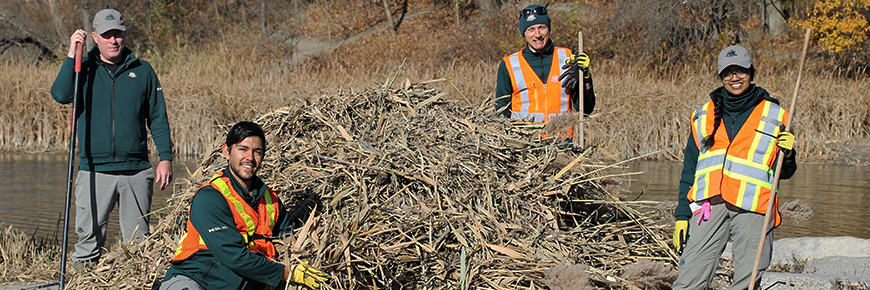
The removal of "Canada's worst invasive plant" from the Rouge Marsh shows how Parks Canada's restoration and conservation efforts are improving the ecological integrity in this area of the park, which features a level of native biodiversity not found anywhere else in Toronto.
An invasive species management crew, along with Parks Canada staff and Indigenous partners, have removed dense stands of European Common Reed (Phragmites australis) from the marsh wetlands near Rouge Beach.
The tall perennial grass, native to Eurasia and now found throughout much of Ontario, grows aggressively, crowding out native vegetation and leaving less open water and food for wildlife. In addition to mitigating habitat loss, removing the invasive plants helps to stop their spread as a result of other initiatives being planned as part of Parks Canada's Rouge Beach Improvements Project.
The Parks Canada impact assessment process
The Parks Canada impact assessment process has been developed to fulfil legal obligations under the Impact Assessment Act, as well as other legal and mandated obligations to protect and present Canada's natural and cultural heritage. Projects and activities with the greatest potential to result in adverse impacts to important natural or cultural resources are assigned to an in-depth, but focused level of analysis through the Detailed Impact Assessment, or DIA, impact assessment pathway. DIAs support decision-making by providing appropriate and rigorous analysis based on sound science, Indigenous knowledge, and Parks Canada policy.
Every DIA involves the following elements:
- early integration into the project planning process;
- the careful identification and selection of valued components (VCs);
- the application of evidence based decision-making; an appropriate level of public engagement; and
- Indigenous engagement and/or Indigenous consultation.
These elements provide the focus, rigour and inclusiveness necessary for the assessment of complex proposals, in a manner appropriate to the potential for adverse environmental impacts.
The public engagement process for the DIA is currently under development. At a minimum, notification of the DIA will be posted on the Canadian Impact Assessment Registry and the draft DIA will be made available for public comment.
Recent improvements to the Rouge Beach upper parking lot

In early August 2020, Parks Canada made some much needed improvements to the upper parking lot at Rouge Beach. These improvements include:
- Adding a solid yellow line to delineate traffic lanes along the main road down to the lower parking lot
- Improved identification of the multi-use pedestrian/cyclist laneway by adding a "flexpost" barrier with reflectors and signage
- Improved Parks Canada signage at the site to increase visitor awareness of multi-use lanes while in the parking lot
- Re-grading gravel parking lot which eliminated potholes
These changes above will make it safer for drivers, pedestrians, and cyclists to use this space. The Rouge is committed on working with the local Councillor and the community on improving this area of the park!
A pattern of flooding at Rouge Beach

During the 2017 and 2019 summer season, flooding at Rouge Beach effectively closed the beach access for the majority of the operational season. As you can see from the photos, the high water levels flooded the entire parking area, the trail to the beach, and caused extensive erosion and damage to the shoreline and paved areas. Flooding also created unsanitary and unsafe conditions, making it dangerous for public use.
The frequency and severity of rising water levels and weather events is one of many key issues park planners are considering as we work to protect the ecological integrity and the enjoyment of this site for generations to come.
February community walks - thanks!

From November to February, project managers conducted site visits and meetings with multiple partners and stakeholders including the Waterfront Regeneration Trust; the West Rouge Community Association; The Friends of Rouge National Urban Park; the Rouge National Urban Park First Nations Advisory Circle; the Pickering Rouge Canoe Club; the Pickering Naturalists; Councillor McKelvie; and the Honourable David Crombie. We look forward to continued collaboration with these and other groups in the coming months.
On February 16th, 17th, 21st, and 22nd, Rouge National Urban Park hosted local community tours of the Rouge Beach and proposed trail options. Organised by the West Rouge Community Association and the Waterfront Regeneration Trust, over 50 people participated in the community tours and the discussion and feedback received will help further inform conversations and decisions around the future of this much loved and important area.
Thank you for sharing your feedback!
The What We Heard Report is now available for the Rouge Beach Improvements Project, summarizing 15 months of public engagement.
The comment period for the Detailed Impact Assessment is now closed. All feedback received is currently being reviewed and considered by Parks Canada for inclusion in the final DIA. A report will be released soon that will summarize the public comments received, and an indication of the design changes made as a result. Once finalized, the public may request a final version of the DIA by sending an email to projetsrouge-rougeprojects@pc.gc.ca.
Parks Canada sincerely thanks all those who took the time to comment and share their opinions, ideas, and suggestions about the proposed improvements to the area.
- Date modified :
